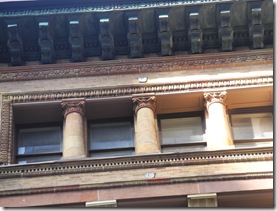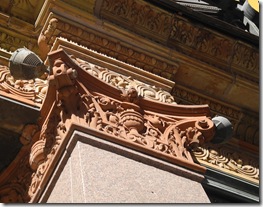If ever a building qualified as a place where thousands visit each week, but is rarely noticed, the venerable Hudson’s Bay building at Queen and Yonge Streets would perhaps take first prize. It has been an integral part of the downtown core for over a century, and similar to many other of Toronto’s architectural gems, few take notice of its fine lines and superb detailing.
Older residents of the city remember it as the Robert Simpson Department Store, the rival of the T. Eaton Company, in the days when the corner of Yonge and Queen Streets was the commercial heart of the city. In the early decades of the 20th century, there were no malls or box-stores. Few people owned an automobiles, and when shopping for major items, everyone travelled downtown on the old Peter Witt streetcars to shop at one or the other of the two large department stores. For daily needs, the corner store supplied the needs of Toronto’s residents.
The Bay at Queen and Yonge Streets formerly the Robert Simpson Company (Simpson’s)
Robert Simpson was born in Inverness, Scotland in 1856. In 1872 he opened a dry goods store on Yonge Street, north of Queen. In 1881, he relocated his shop to the southwest corner of Queen and Yonge Streets. The site at one time had been owned by the rich landowner and tanner, Jesse Ketchum, who willed the land to the Presbyterian Church. Robert Simpson bought most of the church’s property.
In his store at Yonge and Queen, Simpson shocked the residents of staid old Toronto by advertising women’s corsets in his newspaper advertisements. He also hired a female clerk in the women’s department on the second floor. His business prospered to such an extent that he decided to engage in a daring new enterprise, the high-rise department store. He hired the firm of Burke and Harwood to design the building, Edmund Burke accepting the assignment.
There was another reason that Simpson decided to expand. In 1893, the old horse-drawn streetcars on Queen Street were electrified. This created a “rapid transit” line extending into the western and eastern ends of the city. The Yonge Street line had already been electrified three years before, and it was the city’s busiest route. With the newly electrified Queen Street route, it was obvious that the intersection at Queen and Yonge was to be the most advantageous commercial location in Toronto.
In 1894, Robert Simpson opened his magnificent 6-storey department store opened. A brochure published by the company declared, “The opening of the Simpson’s handsome new structure, designed in the fashionable Romanesque style, was an event in 1894.” However, although it possessed steel columns and beams, less than a year after the opening, it was destroyed by fire.
This did not deter the enterprising merchant. Hiring the same architect, he ordered that another building be created, the new one to reflect the “Chicago Style School. As well, the new structure was to be fire-proof, the first such building in Canada. Columns and beams were encased in concrete, and the floors were constructed of fire-resistant materials. The steel skeleton of the building supported the weight, allowing larger interior spaces than had ever seen before in a Toronto store. Large windows added to the feeling of open space and light. He added a new invention – escalators- and also included baby-sitting services, washrooms, writing rooms, and waiting rooms.
In 1907-1908 he built a nine-story addition on the Queen Street side, to the west of the original building. In 1912 another addition was built on the Yonge Street side, extending the store as far south as Richmond Street. It was now the largest retail store in Canada. In 1923 another addition was added on the Queen Street side. In 1928, all the street facades were unified to create a harmonized appearance.
In 1928-1929, an Art Deco building was added to the complex. It was located at Bay and Richmond Streets. It included the Arcadian Court. The great entrance way to this structure, on its Bay Street side, is just as impressive now as when it was built. The glass tower at the corner of Bay and Yonge was added in 1971.
The Hudson’s Bay Company bought the store in 1978, and began operating the business under its own name in 1991. It is now under American ownership and management.
Classical details on The Bay Store
The spacious interior of The Bay (Simpson’s)
Passageway that today connects The Bay to the Eaton Centre. It was inserted into one of the windows of the old Simpson’s Store.
Magnificent entranceway to the Art Deco addition of 1928-29, located on east side of Bay Street.
People crossing Queen Street between the Simpson’s and Eaton’s Stores in 1913
Richmond Street facade of the Simpson’s Store in 1913, with the company’s carts and horses ready to deliver the day’s deliveries.
The above archival photographs are from the collection of the City of Toronto Archives
The Bay has retained the old Simpson’s tradition of maintaining the best Christmas windows in the city.
To view the Home Page for this blog: https://tayloronhistory.com/
To view previous posts about movie houses of Toronto—old and new
https://tayloronhistory.com/2013/10/09/links-to-toronto-old-movie-housestayloronhistory-com/
To view links to other posts placed on this blog about the history of Toronto and its heritage buildings:
https://tayloronhistory.com/2013/10/08/links-to-historic-architecture-of-torontotayloronhistory-com/
Recent publication entitled “Toronto’s Theatres and the Golden Age of the Silver Screen,” by the author of this blog. The publication explores 50 of Toronto’s old theatres and contains over 80 archival photographs of the facades, marquees and interiors of the theatres. It also relates anecdotes and stories from those who experienced these grand old movie houses.
To place an order for this book:
Theatres Included in the Book
Chapter One – The Early Years—Nickelodeons and the First Theatres in Toronto
Theatorium (Red Mill) Theatre—Toronto’s First Movie Experience and First Permanent Movie Theatre, Auditorium (Avenue, PIckford), Colonial Theatre (the Bay), thePhotodome, Revue Theatre, Picture Palace (Royal George), Big Nickel (National, Rio), Madison Theatre (Midtown, Capri, Eden, Bloor Cinema, Bloor Street Hot Docs), Theatre Without a Name (Pastime, Prince Edward, Fox)
Chapter Two – The Great Movie Palaces – The End of the Nickelodeons
Loew’s Yonge Street (Elgin/Winter Garden), Shea’s Hippodrome, The Allen (Tivoli), Pantages (Imperial, Imperial Six, Ed Mirvish), Loew’s Uptown
Chapter Three – Smaller Theatres in the pre-1920s and 1920s
Oakwood, Broadway, Carlton on Parliament Street, Victory on Yonge Street (Embassy, Astor, Showcase, Federal, New Yorker, Panasonic), Allan’s Danforth (Century, Titania, Music Hall), Parkdale, Alhambra (Baronet, Eve), St. Clair, Standard (Strand, Victory, Golden Harvest), Palace, Bedford (Park), Hudson (Mount Pleasant), Belsize (Crest, Regent), Runnymede
Chapter Four – Theatres During the 1930s, the Great Depression
Grant ,Hollywood, Oriole (Cinema, International Cinema), Eglinton, Casino, Radio City, Paramount, Scarboro, Paradise (Eve’s Paradise), State (Bloordale), Colony, Bellevue (Lux, Elektra, Lido), Kingsway, Pylon (Royal, Golden Princess), Metro
Chapter Five – Theatres in the 1940s – The Second World War and the Post-War Years
University, Odeon Fairlawn, Vaughan, Odeon Danforth, Glendale, Odeon Hyland, Nortown, Willow, Downtown, Odeon Carlton, Donlands, Biltmore, Odeon Humber, Town Cinema
Chapter Six – The 1950s Theatres
Savoy (Coronet), Westwood
Chapter Seven – Cineplex and Multi-screen Complexes
Cineplex Eaton Centre, Cineplex Odeon Varsity, Scotiabank Cineplex, Dundas Square Cineplex, The Bell Lightbox (TIFF)







![f1244_it0494[1] f1244_it0494[1]](https://tayloronhistory.com/wp-content/uploads/2012/04/f1244_it04941_thumb.jpg)


